Myanmar Army
The Myanmar Army (Burmese: တပ်မတော်(ကြည်း), pronounced [taʔmədɔ̀ tɕí]) is the largest branch of the Armed Forces (Tatmadaw) of Myanmar (Burma) and has the primary responsibility of conducting land-based military operations. The Myanmar Army maintains the second largest active force in Southeast Asia after the People's Army of Vietnam.[5] It has clashed against ethnic and political insurgents since its inception in 1948.
| Myanmar Army | |
|---|---|
| တပ်မတော် (ကြည်း) (Burmese) lit. 'Armed Forces (Army)' | |
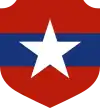 Emblem of the Myanmar Army[lower-alpha 1][1] | |
| Founded | 1945 |
| Country | |
| Type | Ground army |
| Size | 325,000 active personnel[2] Reserves: |
| Part of | |
| Nickname(s) | Tatmadaw Kyi |
| Motto(s) |
|
| Colours |
|
| Anniversaries | 27 March 1945 |
| Engagements | Internal conflict in Myanmar 1960–1961 campaign at the China–Burma border |
| Commanders | |
| Commander-in-Chief (Army) | Vice-Senior General Soe Win |
| Notable commanders |
|
| Insignia | |
| Flag of the Myanmar Army |  |
| Shoulder sleeve of Office of the Commander-in-Chief of Army |  |
| Shoulder sleeve infantry and light infantry |  |
| former Flag (1948-1994) |  |
The force is headed by the Commander-in-Chief of Myanmar Army, currently Vice-Senior General Soe Win, concurrently Deputy Commander-in-Chief of the Defence Services, with Senior General Min Aung Hlaing as the Commander-in-Chief of Defence Services. The highest rank in the Myanmar Army is Senior General, equivalent to field marshal in Western armies and is currently held by Min Aung Hlaing after being promoted from Vice-Senior General.
In 2011, following a transition from military government to civilian parliamentary government, the Myanmar Army imposed a military draft on all citizens: all males from age 18 to 35 and all females from 18 to 27 years of age can be drafted into military service for two years as enlisted personnel in time of national emergency. The ages for professionals are up to 45 for men and 35 for women for three years service as commissioned and non-commissioned officers.
The Government Gazette reported that 1.8 trillion kyat (about US$2 billion), or 23.6 percent of the 2011 budget was for military expenditures.[6]
Brief history
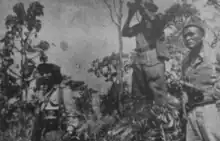
British and Japanese rule
In the late 1930s, during the period of British rule, a few Myanmar organizations or parties formed an alliance named Burma's Htwet-Yet (Liberation) Group, one of them being Dobama Asiayone. Since most of the members were Communist, they wanted help from Chinese Communists; but when Tha-khin Aung San and a partner secretly went to China for help, they only met with a Japanese general and made an alliance with Japanese Army. In the early 1940s, Aung San and other 29 participants secretly went for the military training under Japanese Army and these 30 people are later known as the "30 Soldiers" in Myanmar history and can be regarded as the origin of the modern Myanmar Army.
When the Japanese invasion of Burma was ready, the 30 Soldiers recruited Myanmar people in Thailand and founded Burmese Independence Army (BIA), which was the first phase of Myanmar Army. In 1942, BIA assisted Japanese Army in their conquest of Burma, which succeeded. After that, Japanese Army changed BIA to Burmese Defense Army (BDA), which was the second phase. In 1943, Japan officially declared Burma an independent nation, but the new Burmese government did not possess de facto rule over the country.
While assisting the British Army in 1945, the Myanmar Army entered into its third phase, as the Patriotic Burmese Force (PBF), and the country became under British rule again. Afterwards, the structure of the army fell under British authority; hence, for those who were willing to serve the nation but not in that army, General Aung San organized the People's Comrades force.
Post-Independence era
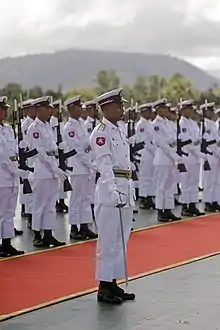
At the time of Myanmar's independence in 1948, the Tatmadaw was weak, small and disunited. Cracks appeared along the lines of ethnic background, political affiliation, organisational origin and different services. Its unity and operational efficiency was further weakened by the interference of civilians and politicians in military affairs, and the perception gap between the staff officers and field commanders. The most serious problem was the tension between ethnic Karen Officers, coming from the British Burma Army and Bamar officers, coming from the Patriotic Burmese Forces (PBF).
In accordance with the agreement reached at Kandy Conference in September 1945, the Tatmadaw was reorganised by incorporating the British Burma Army and the Patriotic Burmese Forces. The officer corps shared by ex-PBF officers and officers from British Burma Army and Army of Burma Reserve Organisation (ARBO). The colonial government also decided to form what were known as "Class Battalions" based on ethnicity. There were a total of 15 rifle battalions at the time of independence and four of them were made up of former members of PBF. All influential positions within the War Office and commands were manned with non-former PBF Officers. All services including military engineers, supply and transport, ordnance and medical services, Navy and Air Force were all commanded by former officers from ABRO and British Burma Army.
| Battalion | Composition |
|---|---|
| No. 1 Burma Rifles | Bamar (Burma Military Police) |
| No. 2 Burma Rifles | Karen majority + other Non-Bamar Nationalities [commanded by then Lieutenant Colonel Saw Chit Khin [Karen officer from British Burma Army]) |
| No. 3 Burma Rifles | Bamar / former members of Patriotic Burmese Forces |
| No. 4 Burma Rifles | Bamar / former members of Patriotic Burmese Force – Commanded by the then Lieutenant Colonel Ne Win |
| No. 5 Burma Rifles | Bamar / former members of Patriotic Burmese Force |
| No. 6 Burma Rifles | Bamar / former members of Patriotic Burmese Force |
| No. 1 Karen Rifles | Karen / former members of British Burma Army and ABRO |
| No. 2 Karen Rifles | Karen / former members of British Burma Army and ABRO |
| No. 3 Karen Rifles | Karen / former members of British Burma Army and ABRO |
| No. 1 Kachin Rifles | Kachin / former members of British Burma Army and ABRO |
| No. 2 Kachin Rifles | Kachin / former members of British Burma Army and ABRO |
| No. 1 Chin Rifles | Chin / former members of British Burma Army and ABRO |
| No. 2 Chin Rifles | Chin / former members of British Burma Army and ABRO |
| No. 4 Burma Regiment | Gurkha |
| Chin Hill Battalion | Chin |
Formation and structure
The army has always been by far the largest service in Myanmar and has always received the lion's share of the defence budget.[7][8] It has played the most prominent part in Myanmar's struggle against the 40 or more insurgent groups since 1948 and acquired a reputation as a tough and resourceful military force. In 1981, it was described as 'probably the best army in Southeast Asia, apart from Vietnam's'.[9] The judgement was echoed in 1983, when another observer noted that "Myanmar's infantry is generally rated as one of the toughest, most combat seasoned in Southeast Asia".[10] In 1985, a foreign journalist with the rare experience of seeing Burmese soldiers in action against ethnic insurgents and narco-armies was "thoroughly impressed by their fighting skills, endurance and discipline".[11] Other observers during that period characterised the Myanmar Army as "the toughest, most effective light infantry jungle force now operating in Southeast Asia".[12] Even the Thai people, not known to praise the Burmese lightly, have described the Myanmar Army as "skilled in the art of jungle warfare".[13]
Organisation
The Myanmar Army had reached some 370,000 active troops of all ranks in 2000. There were 337 infantry battalions, including 266 light infantry battalions as of 2000. Although the Myanmar Army's organisational structure was based upon the regimental system, the basic manoeuvre and fighting unit is the battalion, known as Tat Yinn ((တပ်ရင်း)) in Burmese. This is composed of a headquarters unit; five rifle companies Tat Khwe ((တပ်ခွဲ)) with three rifle platoons Tat Su ((တပ်စု)) each; an administrative company with medical, transport, logistics, and signals units; a heavy weapons company including mortar, machine gun, and recoilless gun platoons. Each battalion is commanded by a lieutenant colonel Du Ti Ya Bo Hmu Gyi or Du Bo Hmu Gyi with a major (bo hmu) as second in command, with a total strength of 27 officers and 723 other ranks. Light infantry battalions in the Myanmar Army have much lower establishment strength of around 500; this often leads to these units being mistakenly identified by observers as under-strength infantry battalions.
With its significantly increased personnel numbers, weaponry, and mobility, today's Tatmadaw Kyee (တပ်မတော်(ကြည်း)) is a formidable conventional defence force for the Union of Myanmar. Troops ready for combat duty have at least doubled since 1988. Logistics infrastructure and artillery fire support have been greatly increased. Its newly acquired military might was apparent in the Tatmadaw's dry season operations against Karen National Union (KNU) strongholds in Manerplaw and Kawmura. Most of the casualties at these battles were the result of intense and heavy bombardment by the Tatmadaw Kyee. The Tatmadaw Kyee is now much larger than it was before 1988, it is more mobile and has greatly improved armour, artillery, and air defence inventories. Its C3I (Command, Control, Communications, Computers and Intelligence) systems have been expanded and refined. It is developing larger and more integrated, self-sustained formations to improve coordinated action by different combat arms. The army may still have relatively modest weaponry compared to its larger neighbours, but it is now in a much better position to deter external aggression and respond to such a threat should it ever arise, although child soldiers may not perform very well in combating with enemies.[14]
Expansion
The first army division to be formed after the 1988 military coup was the 11th Light Infantry Division (LID) in December 1988 with Colonel Win Myint as commander. In March 1990, a new regional military command was created in Monywa with Brigadier Kyaw Min as commander and named the North-Western Regional Military Command. A year later, 101st LID was formed in Pakokku with Colonel Saw Tun as commander. Two Regional Operations Commands (ROC) were formed in Myeik and Loikaw to improve command and control. They were commanded respectively by Brigadier Soe Tint and Brigadier Maung Kyi. March 1995 saw a dramatic expansion of the Tatmadaw as it established 11 Military Operations Commands (MOC)s in that month. MOC are similar to mechanised infantry divisions in Western armies, each with 10 regular infantry battalions (Chay Hlyin Tatyin), a headquarters, and organic support units including field artillery. In 1996, two new RMC were opened, Coastal Region RMC was opened in Myeik with Brigadier Sit Maung as commander and Triangle Region RMC in Kengtung with Brigadier Thein Sein as commander. Three new ROCs were created in Kalay, Bhamo and Mongsat. In late 1998, two new MOCs were created in Bokepyin and Mongsat.[15]
The most significant expansion after the infantry in the army was in armour and artillery. Beginning in 1990, the Tatmadaw procured 18 T-69II main battle tanks and 48 T-63 amphibious light tanks from China. Further procurements were made, including several hundred Type 85 and Type 92 armoured personnel carriers (APC). By the beginning of 1998, Tatmadaw had about 100 T-69II main battle tanks, a similar number of T-63 amphibious light tanks, and several T-59D tanks. These tanks and armoured personnel carriers were distributed throughout five armoured infantry battalions and five tank battalions and formed the first armoured division of the Tatmadaw as the 71st Armoured Operations Command with its headquarters in Pyawbwe.
Bureau of Special Operations (BSO)
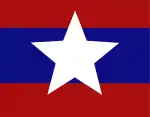
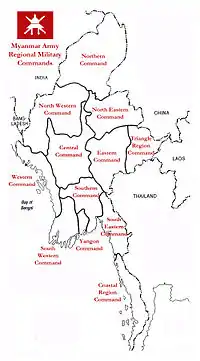
The Bureau of Special Operations (ကာကွယ်ရေးဌာန စစ်ဆင်ရေး အထူးအဖွဲ့) in the Myanmar Army are high-level field units equivalent to field armies in Western terms and consist of two or more regional military commands (RMC) commanded by a lieutenant general and six staff officers.
The units were introduced under the General Staff Office on 28 April 1978 and 1 June 1979. In early 1978, the Chairman of BSPP, General Ne Win, visited the Northeastern Command Headquarters in Lashio to receive a briefing about Burmese Communist Party (BCP) insurgents and their military operations. He was accompanied by Brigadier General Tun Ye from the Ministry of Defence. Brigadier General Tun Ye was the regional commander of the Eastern Command for three years and before that he served in Northeastern Command areas as commander of Strategic Operation Command (SOC) and commander of Light Infantry Divisions for four years. As BCP military operations were spread across three Regional Military Command (RMC) areas (Northern, Eastern, and Northeastern), Brigadier General Tun Ye was the most informed commander about the BCP in the Myanmar Army at the time. At the briefing, General Ne Win was impressed by Brigadier General Tun Ye and realised that co-ordination among various Regional Military Commands (RMC) was necessary; thus, decided to form a bureau at the Ministry of Defence.
Originally, the bureau was for "special operations", wherever they were, that needed co-ordination among various Regional Military Commands (RMC). Later, with the introduction of another bureau, there was a division of command areas. The BSO-1 was to oversee the operations under the Northern Command, Northeastern Command, the Eastern Command, and the Northwestern Command. BSO-2 was to oversee operations under the Southeastern Command, Southwestern Command, Western Command and Central Command.
Initially, the chief of the BSO had the rank of brigadier general. The rank was upgraded to major general on 23 April 1979. In 1990, it was further upgraded to lieutenant general. Between 1995 and 2002, Chief of Staff (Army) jointly held the position of Chief of BSO. However, in early 2002, two more BSO were added to the General Staff Office; therefore there were altogether four BSOs. The fifth BSO was established in 2005 and the sixth in 2007.
Currently there are six Bureaus of Special Operations in the Myanmar order of battle.[16]
| Bureau of Special Operations | Regional Military Commands (RMC) | Chief of Bureau of Special Operations | Notes |
|---|---|---|---|
| Bureau of Special Operations 1 | Central Command Northwestern Command Northern Command |
Lt. Gen. Tay Zar Kyaw | |
| Bureau of Special Operations 2 | Northeastern Command Eastern Command Triangle Region Command Eastern Central Command |
Lt. Gen. Aung Zaw Aye | |
| Bureau of Special Operations 3 | Southwestern Command Southern Command Western Command |
Lt. Gen. Phone Myat | |
| Bureau of Special Operations 4 | Coastal Command Southeastern Command |
Lt. Gen. Aung Soe | |
| Bureau of Special Operations 5 | Yangon Command | Lt. Gen. Thet Pon | |
| Bureau of Special Operations 6 | Naypyidaw Command | Lt. Gen. Than Hlaing |
Regional Military Commands (RMC)
For better command and communication, the Tatmadaw formed a Regional Military Commands (တိုင်း စစ်ဌာနချုပ်) structure in 1958. Until 1961, there were only two regional commands, they were supported by 13 infantry brigades and an infantry division. In October 1961, new regional military commands were opened and leaving only two independent infantry brigades. In June 1963, the Naypyidaw Command was temporarily formed in Yangon with the deputy commander and some staff officers drawn from Central Command. It was reorganised and renamed as Yangon Command on 1 June 1965.
A total of 337 infantry and light infantry battalions organised in Tactical Operations Commands, 37 independent field artillery regiments supported by affiliated support units including armoured reconnaissance and tank battalions. RMCs are similar to corps formations in Western armies. The RMCs, commanded by major general, are managed through a framework of Bureau of Special Operations (BSOs), which are equivalent to field army group in Western terms.
| Regional Military Command (RMC) | Badge | States & Divisions | Headquarters | Strength |
|---|---|---|---|---|
| Northern Command
(မြောက်ပိုင်းတိုင်းစစ်ဌာနချုပ်) |
 |
Kachin State | Myitkyina | 32 Infantry Battalions |
| Northeastern Command
(အရှေ့မြောက်ပိုင်းတိုင်းစစ်ဌာနချုပ်) |
 |
Northern Shan State | Lashio | 30 Infantry Battalions |
| Eastern Command
(အရှေ့ပိုင်းတိုင်းစစ်ဌာနချုပ်) |
 |
Southern Shan State and Kayah State | Taunggyi | 42 Infantry Battalions including 16× Light Infantry Battalions under Regional Operation Command (ROC) Headquarters at Loikaw |
| Southeastern Command
(အရှေ့တောင်တိုင်းစစ်ဌာနချုပ်) |
.svg.png.webp) |
Mon State and Kayin State | Mawlamyine | 40 × Infantry Battalions |
| Southern Command
(တောင်ပိုင်းတိုင်းစစ်ဌာနချုပ်) |
 |
Bago and Magwe Divisions | Toungoo | 27 × Infantry Battalions |
| Western Command
(အနောက်ပိုင်းတိုင်းစစ်ဌာနချုပ်) |
 |
Rakhine State and Chin State | Ann | 31 × Infantry Battalions |
| Southwestern Command
(အနောက်တောင်တိုင်းစစ်ဌာနချုပ်) |
 |
Ayeyarwady Division (Irrawaddy Division) | Pathein (Bassein) | 11 × Infantry Battalions |
| Northwestern Command
(အနောက်မြောက်တိုင်းစစ်ဌာနချုပ်) |
 |
Sagaing Division | Monywa | 25 × Infantry Battalions |
| Yangon Command
(ရန်ကုန်တိုင်းစစ်ဌာနချုပ်) |
 |
Yangon Division | Mayangone Township-Kone-Myint-Thar | 11 × Infantry Battalions |
| Coastal Region Command
(ကမ်းရိုးတန်းတိုင်းစစ်ဌာနချုပ်) |
 |
Tanintharyi Division (Tenassarim Division) | Myeik (Mergui) | 43 Infantry Battalions including battalions under 2 MOC based at Tavoy |
| Triangle Region Command
(တြိဂံတိုင်းစစ်ဌာနချုပ်) |
 |
Eastern Shan State | Kyaingtong (Kengtung) | 23 Infantry Battalions |
| Central Command
(အလယ်ပိုင်းတိုင်းစစ်ဌာနချုပ်) |
 |
Mandalay Division | Mandalay | 31 Infantry Battalions |
| Naypyidaw Command
(နေပြည်တော်တိုင်းစစ်ဌာနချုပ်) |
 |
Naypyidaw | Pyinmana | Formed in 2006 – ? × Infantry Battalions |
| Eastern Central Command
(အရှေ့အလယ်ပိုင်းတိုင်းစစ်ဌာနချုပ်) |
 |
Middle Shan State | Namsang | Formed in 2011 – 7 × Infantry Battalions |
Commanders of Regional Military Commands
| Regional Military Command (RMC) | Established | First Commander | Current Commander | Notes |
|---|---|---|---|---|
| Eastern Command | 1961 | Brigadier General San Yu | Brigadier General Ni Lin Aung | Initially in 1961, San Yu was appointed as Commander of Eastern Command but was moved to NW Command and replaced with Col. Maung Shwe then. |
| Southeastern Command | 1961 | Brigadier General Sein Win | Major General Ko Ko Maung | In 1961 when SE Command was formed, Sein Win was transferred from former Southern Command but was moved to Central Command and replaced with Thaung Kyi then. |
| Central Command | 1961 | Colonel Thaung Kyi | Major General Ko Ko Oo | Original NW Command based at Mandalay was renamed Central Command in March 1990 and original Central Command was renamed Southern Command |
| Northwestern Command | 1961 | Brigadier General Kyaw Min | Major General Than Htike | Southern part of original Northwestern Command in Mandalay was renamed Central Command in March 1990 and northern part of original NW Command was renamed NW Command in 1990. |
| Southwestern Command | 1961 | Colonel Kyi Maung | Major General Aung Aung | Kyi Maung was sacked in 1963 and was imprisoned a few times. He became Deputy Chairman of NLD in the 1990s. |
| Yangon Command | 1969 | Colonel Thura Kyaw Htin | Major General Nyunt Win Swe | Formed as Naypyidaw Command in 1963 with deputy commander and some staff officers from Central Command. Reformed and renamed Yangon Command on 1 June 1969. |
| Western Command | 1969 | Colonel Hla Tun | Major General Htin Latt Oo | |
| Northeastern Command | 1972 | Colonel Aye Ko | Brigadier General Naing Naing Oo | |
| Northern Command | 1947 | Brigadier Ne Win | Brigadier General Myat Thet Oo | Original Northern Command was divided into Eastern Command and NW Command in 1961. Current Northern Command was formed in 1969 as a part of reorganisation and is formed northern part of previous NW Command |
| Southern Command | 1947 | Brigadier Saw Kya Doe | Brigadier General Htein Win | Original Southern Command in Mandalay was renamed Central Command in March 1990 |
| Triangle Region Command | 1996 | Brigadier General Thein Sein | Brigadier General Myo Min Tun | Thein Sein later became Prime Minister and elected as president in 2011 |
| Coastal Region Command | 1996 | Brigadier General Thiha Thura Thura Sit Maung | Major General Saw Than Hlaing | |
| Naypyidaw Command | 2005 | Brigadier Wei Lwin | Major General Zaw Hein | |
| Eastern Central Command | 2011 | Brigadier Mya Tun Oo | Brigadier General Hla Moe |
Regional Operations Commands (ROC)
Regional Operations Commands (ROC) (ဒေသကွပ်ကဲမှု စစ်ဌာနချုပ်) are commanded by a brigadier general, are similar to infantry brigades in Western Armies. Each consists of 4 Infantry battalions (Chay Hlyin Tatyin), HQ and organic support units. Commander of ROC is a position between LID/MOC commander and tactical Operation Command (TOC) commander, who commands three infantry battalions. The ROC commander holds financial, administrative and judicial authority while the MOC and LID commanders do not have judicial authority.[8][17]
| Regional Operation Command (ROC) | Headquarters | Notes |
|---|---|---|
| Loikaw Regional Operations Command | Loikaw (လွိုင်ကော်) Kayah State | |
| Laukkai Regional Operations Command | Laukkai (လောက်ကိုင်), Shan State | |
| Kalay Regional Operations Command | Kalay (ကလေး), Sagaing Division | |
| Sittwe Regional Operations Command | Sittwe (စစ်တွေ), Rakhine State | |
| Pyay Regional Operations Command | Pyay (ပြည်), Bago Division | |
| Tanaing Regional Operations Command | Tanaing (တနိုင်း), Kachin State | Formerly ROC Bhamo |
| Wanhseng Regional Operations Command | Wanhseng, Shan State | Formed in 2011[18] |
Military Operations Commands (MOC)
Military Operations Commands (MOC) (စစ်ဆင်ရေးကွပ်ကဲမှုဌာနချုပ်), commanded by a brigadier-general are similar to Infantry Divisions in Western Armies. Each consists of 10 Mechanised Infantry battalions equipped with BTR-3 armoured personnel carriers, Headquarters and support units including field artillery batteries. These ten battalions are organised into three Tactical Operations Commands: one Mechanised Tactical Operations Command with BTR-3 armoured personnel carriers, and two Motorized Tactical Operations Command with EQ-2102 6x6 trucks.
MOC are equivalent to Light Infantry Divisions (LID) in the Myanmar Army order of battle as both command 10 infantry battalions through three TOC's (Tactical Operations Commands). However, unlike Light Infantry Divisions, MOC are subordinate to their respective Regional Military Command (RMC) Headquarters.[17] Members of MOC does not wear distinguished arm insignias and instead uses their respective RMC's arm insignias. For example, MOC-20 in Kawthaung wore the arm insignia of Coastal Region Military Command.
| Military Operation Command (MOC) | Headquarters | Notes |
|---|---|---|
| 1st Military Operations Command (MOC-1) | Kyaukme, Shan State | |
| 2nd Military Operations Command (MOC-2) | Mong Nawng, Shan State | |
| 3rd Military Operations Command (MOC-3) | Mogaung, Kachin State | |
| 4th Military Operations Command (MOC-4) | Hpugyi, Yangon Region | Designated Airborne Division |
| 5th Military Operations Command (MOC-5) | Taungup, Rakhine State | |
| 6th Military Operations Command (MOC-6) | Pyinmana (ပျဉ်းမနား), Mandalay Region | |
| 7th Military Operations Command (MOC-7) | Hpegon (ဖယ်ခုံ), Shan State | |
| 8th Military Operations Command (MOC-8) | Dawei (ထားဝယ်), Tanintharyi Region | |
| 9th Military Operations Command (MOC-9) | Kyauktaw (ကျောက်တော်), Rakhine State | |
| 10th Military Operations Command (MOC-10) | Kyigon (ကျီကုန်း (ကလေးဝ)), Sagaing Region | |
| 11th Military Operations Command (MOC-11) | ||
| 12th Military Operations Command (MOC-12) | Kawkareik (ကော့ကရိတ်), Kayin State | |
| 13th Military Operations Command (MOC-13) | Bokpyin (ဘုတ်ပြင်း), Tanintharyi Region | |
| 14th Military Operations Command (MOC-14) | Mong Hsat (မိုင်းဆတ်), Shan State | |
| 15th Military Operations Command (MOC-15) | Buthidaung (ဘူးသီးတောင်), Rakhine State | |
| 16th Military Operations Command (MOC-16) | Theinni (သိန်းနီ), Shan State | |
| 17th Military Operations Command (MOC-17) | Mong Pan (မိုင်းပန်), Shan State | |
| 18th Military Operations Command (MOC-18) | Mong Hpayak (မိုင်းပေါက်), Shan State | |
| 19th Military Operations Command (MOC-19) | Ye (ရေး), Mon State | |
| 20th Military Operations Command (MOC-20) | Kawthaung (ကော့သောင်း), Tanintharyi Region | |
| 21st Military Operations Command (MOC-21) | Bhamo (ဗန်းမော်), Kachin State |
Light Infantry Divisions (LID)
Light Infantry Division (ခြေမြန်တပ်မ or တမခ), commanded by a brigadier general, each with 10 Light Infantry Battalions organised under 3 Tactical Operations Commands, commanded by a Colonel (3 battalions each and 1 reserve), 1 Field Artillery Battalion, 1 Armour Squadron and other support units.[8][17]
These divisions were first introduced to the Myanmar Army in 1966 as rapid reaction mobile forces for strike operations. 77th Light Infantry Division was formed on 6 June 1966, followed by 88th Light Infantry Division and 99th Light Infantry Division in the two following years. 77th LID was largely responsible for the defeat of the Communist forces of the CPB (Communist Party of Burma) based in the forested hills of the central Bago Mountains in the mid-1970s. Three more LIDs were raised in the latter half of the 1970s (the 66th, 55th and 44th) with their headquarters at Pyay, Aungban and Thaton. They were followed by another two LIDs in the period prior to the 1988 military coup (the 33rd LID with headquarters at Sagaing and the 22nd LID with headquarters at Hpa-An). 11th LID was formed in December 1988 with headquarters at Inndine, Bago Division and 101st LID was formed in 1991 with its headquarters at Pakokku.[8][17]
Each LID, commanded by Brigadier General (Bo hmu gyoke) level officers, consists of 10 light infantry battalions specially trained in counter-insurgency, jungle warfare, "search and destroy" operations against ethnic insurgents and narcotics-based armies. These battalions are organised under three Tactical Operations Commands (TOC; Nee byu har). Each TOC, commanded by a Colonel (Bo hmu gyi), is made up of three or more combat battalions, with command and support elements similar to that of brigades in Western armies. One infantry battalion is held in reserve. As of 2000, all LIDs have their own organic Field Artillery units. For example, 314th Field Artillery Battery is now attached to 44th LID. Some of the LID battalions have been given Parachute and Air Borne Operations training and two of the LIDs have been converted to mechanised infantry formation with divisional artillery, armoured reconnaissance and tank battalions[8]
LIDs are considered to be a strategic asset of the Myanmar Army, and after the 1990 reorganisation and restructuring of the Tatmadaw command structure, they are now directly answerable to Chief of Staff (Army).[8][17]
| Light Infantry Division (LID) | Badge | Year formed | Headquarters | First commander | Current commander | Notes |
|---|---|---|---|---|---|---|
| 11th Light Infantry Division | 11th Light Infantry Division | 1988 | Inndine | Col. Win Myint | Formed after 1988 military coup. | |
| 22nd Light Infantry Division | 22nd Light Infantry Division | 1987 | Hpa-An | Col. Tin Hla | Involved in crackdown of unarmed protestors during 8.8.88 democracy uprising | |
| 33rd Light Infantry Division | 33rd Light Infantry Division | 1984 | Mandalay/later Sagaing | Col. Kyaw Ba | Involved in crackdown against the Rohingya in northern Rakhine state[19]
Involved in the Kachin conflict | |
| 44th Light Infantry Division | 44th Light Infantry Division | 1979 | Thaton | Col. Myat Thin | ||
| 55th Light Infantry Division | 55th Light Infantry Division | 1980 | Sagaing/later Kalaw | Col. Phone Myint | ||
| 66th Light Infantry Division | 66th Light Infantry Division | 1976 | Innma | Col. Taung Zar Khaing | ||
| 77th Light Infantry Division | 77th Light Infantry Division | 1966 | Hmawbi/later Bago | Col. Tint Swe | ||
| 88th Light Infantry Division | 88th Light Infantry Division | 1967 | Magway | Col. Than Tin | Units of 88th LID were deployed in Yangon and other regions to crackdown on protesters in 2021 | |
| 99th Light Infantry Division | 99th Light Infantry Division | 1968 | Meiktila | Col. Kyaw Htin | Involved in crackdown against the Rohingya in northern Rakhine state[19] | |
| 101st Light Infantry Division | 101st Light Infantry Division | 1991 | Pakokku | Col. Saw Tun | Units of 101st LID were deployed during the purge of Military Intelligence faction in 2004. | |
| 343rd Light Infantry Battalion |
|
[20] | ||||
Missile, Artillery and armoured units
Missile, Artillery and armoured units were not used in an independent role, but were deployed in support of the infantry by the Ministry of Defence as required. The Directorate of Artillery and Armour Corps was also divided into separate corps in 2001. The Directorate of Artillery and Missile Corps was also divided into separate corps in 2009. A dramatic expansion of forces under these directorates followed with the equipment procured from China, Russia, Ukraine and India.[8] [17]
No(1) Missile Operational Command MOC(1)
- HQ battalion
- 10 Missile Battalions
Directorate of Artillery (Myanmar Artillery)
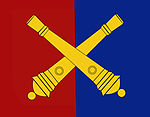
No. 1 Artillery Battalion was formed in 1952 with three artillery batteries under the Directorate of Artillery Corps. A further three artillery battalions were formed in the late 1952. This formation remained unchanged until 1988. Since 2000, the Directorate of Artillery Corps has overseen the expansion of Artillery Operations Commands(AOC) from two to 10. Tatmadaw's stated intention is to establish an organic Artillery Operations Command in each of the 12 Regional Military Command Headquarters. Each Artillery Operation Command is composed of the following:
As of 2000, the Artillery wing of the Tatmadaw has about 60 battalions and 37 independent Artillery companies/batteries attached to various Regional Military Commands (RMC), Light Infantry Divisions (LID), Military Operation Command (MOC) and Regional Operation Command (ROC). For example, 314th Artillery Battery is under 44th LID, 326 Artillery Battery is attached to 5th MOC, 074 Artillery Battery is under the command of ROC (Bhamo) and 076 Artillery Battery is under North-Eastern RMC. Twenty of these Artillery battalions are grouped under 707th Artillery Operation Command (AOC) headquarters in Kyaukpadaung and 808th Artillery Operation Command (AOC) headquarters in Oaktwin, near Taungoo. The remaining 30 battalions, including 7 Anti-Aircraft artillery battalions are under the Directorate of Artillery Corps.[8] [17]
Artillery Operations Command (AOC)
- HQ battalion
- 12 Artillery battalions:
- 6 Light Field artillery battalion equipped with 105 mm, 76 mm, 75 mm howitzers, field guns and mountain guns,
- 3 Medium Field Artillery battalion equipped with 155 mm, 130 mm, 122 mm howitzers and field guns,
- 1 Multiple Rocket Launcher battalion equipped with 122 mm and 240 mm MLRS, self-propelled and towed launchers,
- 1 Air Defence Artillery battalion with 37 mm, 57 mm Anti-Aircraft guns or SA 18 IGLAs) man portable surface-to-air missiles and
- 1 target acquisition battalion.
- support units
Light field artillery battalions consists of 3 field artillery batteries with 36 field guns or howitzers (12 guns per battery). Medium artillery battalions consists of 3 medium artillery batteries of 18 field guns or howitzers (6 guns per one battery). As of 2011, all field guns of Myanmar Artillery Corps are undergoing upgrade programs including GPS Fire Control Systems.
| Artillery Operations Command (AOC) | Headquarters | Notes |
|---|---|---|
| 505th Artillery Operations Command | Myeik (မြိတ်) | |
| 707th Artillery Operations Command | Kyaukpadaung (ကျောက်ပန်းတောင်း) | |
| 606th Artillery Operations Command | Thaton (သထုံ) | |
| 808th Artillery Operations Command | Oak Twinn (အုပ်တွင်းမြို့) | |
| 909th Artillery Operations Command | Mong Khon--Kengtung | |
| 901st Artillery Operations Command | Baw Net Gyi (ဘောနက်ကြီး--ပဲခူးတိုင်း) | |
| 902nd Artillery Operations Command | [NAUNG HKIO) | |
| 903rd Artillery Operations Command | [AUNG BAN) | |
| 904th Artillery Operations Command | Mohnyin (မိုးညှင်း) | |
| 905th Artillery Operations Command | Padein--Ngape |
Directorate of Armour (Myanmar Armored Corps)
No. 1 Armour Company and No. 2 Armour Company were formed in July 1950 under the Directorate of Armour and Artillery Corps with Sherman tanks, Stuart light tanks, Humber Scout Cars, Ferret armoured cars and Universal Bren Carriers. These two companies were merged on 1 November 1950 to become No. 1 Armour Battalion with headquarters in Mingalardon. On 15 May 1952 No. Tank Battalion was formed with 25 Comet tanks acquired from the United Kingdom. The Armour Corps within Myanmar Army was the most neglected one for nearly thirty years since the Tatmadaw had not procured any new tanks or armoured carriers since 1961.
Armoured divisions, known as Armoured Operations Command (AROC), under the command of Directorate of Armour Corps, were also expanded in number from one to two, each with four Armoured Combat battalions equipped with Infantry fighting vehicles and armoured personnel carriers, three tank battalions equipped with main battle tanks and three Tank battalions equipped with light tanks. [17] In mid-2003, Tamadaw acquired 139+ T-72 main battle tanks from Ukraine and signed a contract to build and equip a factory in Myanmar to produce and assemble 1,000 BTR armoured personnel carriers in 2004.[21] In 2006, the Government of India transferred an unspecified number of T-55 main battle tanks that were being phased out from active service to Tatmadaw along with 105 mm light field guns, armoured personnel carriers and indigenous HAL Light Combat Helicopters in return for Tatmadaw's support and co-operation in flushing out Indian insurgent groups operating from its soil.[22]
Armoured Operations Command (AROC)
Armoured Operations Commands (AROC) are equivalent to Independent armoured divisions in western terms. Currently there are 5 Armoured Operations Commands under Directorate of Armoured Corps in the Tatmadaw order of battle. Tatmadaw planned to establish an AROC each in 7 Regional Military Commands. Typical armoured divisions in the Myanmar Army are composed of Headquarters, Three Armored Tactical Operations Command – each with one mechanised infantry battalion equipped with 44 BMP-1 or MAV-1 Infantry Fighting Vehicles, Two Tank Battalions equipped with 44 main battle tanks each, one armoured reconnaissance battalion equipped with 32 Type-63A Amphibious Light Tanks, one field artillery battalion and a support battalion. The support battalion is composed of an engineer squadron, two logistic squadrons, and a signal company.
The Myanmar Army acquired about 150 refurbished EE-9 Cascavel armoured cars from an Israeli firm in 2005.[23] Classified in the army's service as a light tank, the Cascavel is currently deployed in the eastern Shan State and triangle regions near the Thai border.
| Armoured Operations Command (ArOC) | Headquarters | Notes |
|---|---|---|
| 71st Armoured Operations Command | Pyawbwe (ပျော်ဘွယ်) | |
| 72nd Armoured Operations Command | Ohntaw (အုန်းတော) | |
| 73rd Armoured Operations Command | Malun (မလွန်) | |
| 74th Armoured Operations Command | Intaing (အင်းတိုင်) | |
| 75th Armoured Operations Command | Thagara (သာဂရ) |
Office of the Chief of Air Defence (Myanmar Air Defence Artillery)
The Office of the chief of Air Defence (လေကြောင်းရန်ကာကွယ်ရေးတပ်ဖွဲ့အရာရှိချုပ်ရုံး) is one of the major branches of Tatmadaw. It was established as the Air Defence Command in 1997, but was not fully operational until late 1999. It was renamed the Bureau of Air Defence in the early 2000s. In early 2000, Tatmadaw established the Myanmar Integrated Air Defence System (MIADS) (မြန်မာ့အလွှာစုံပေါင်းစပ်လေကြောင်းရန်ကာကွယ်ရေးစနစ်) with help from Russia and China. It is a tri-service bureau with units from all three branches of the armed forces. All air defence assets except the Army's anti-aircraft artillery battalions are integrated into the MIADS.[24]
Directorate of Signals (Myanmar Signal Corps)
Soon after the independence in 1948, Myanmar Signal Corps was formed with units from Burma Signals, also known as "X" Branch. It consisted HQ Burma Signals, Burma Signal Training Squadron (BSTS) and Burma Signals Squadron. HQ Burma Signals was located within War Office. BSTS based in Pyain Oo Lwin was formed with Operating Cipher Training Troop, Dispacth Rider Training Troop, Lineman Training Troop, Radio Mechanic Training Troop and Regimental Signals Training Troop. BSS, based in Mingalardon, had nine sections: Administration Troop, Maintenance Troop, Operating Troop, Cipher Troop, Lineman and Dispatch Rider Troop, NBSD Signals Troop, SBSD Signals Troop, Mobile Brigade Signals Toop and Arakan Signals Toop. The then Chief of Signal Staff Officer (CSO) was Lieutenant Colonel Saw Aung Din. BSTS and BSS were later renamed No. 1 Signal Battalion and No.1 Signal Training Battalion. In 1952, the Infantry Divisional Signals Regiment was formed and later renamed to No. 2 Signal Battalion. HQ Burma Signals was reorganised and became Directorate Signal and the director was elevated to the rank of Colonel. In 1956, No. 1 Signal Security Battalion was formed, followed by No. 3 Signal Battalion in November 1958 and No.4 Signal Battalion in October 1959.
In 1961, signal battalions were reorganised as No. 11 Signal Battalion under Northeastern Regional Military Command, No. 121 Signal Battalion under Eastern Command, No. 313 Signal Battalion under Central Command, No.414 Signal Battalion under Southwestern Command, and No. 515 Signal Battalion under Southeastern Command. No.1 Signal Training Battalion was renamed Burma Signal Training Depot (Baho-Setthweye-Tat).
By 1988, Directorate of Signals command one training depot, eight signal battalions, one signal security battalion, one signal store depot and two signal workshops. Signal Corps under Directorate of Signal further expanded during 1990 expansion and reorganisation of Myanmar Armed Forces. By 2000, a signal battalion is attached to each Regional Military Command and signal companies are now attached to Light Infantry Divisions and Military Operations Commands.
In 2000, Command, Control and Communication system of Myanmar Army has been substantially upgraded by setting up the military fibre optic communication network managed by Directorate of Signal throughout the country. Since 2002 all Myanmar Army Regional Military Command HQs used its own telecommunication system. Satellite communication links are also provided to forward-deployed infantry battalions. However, battle field communication systems are still poor. Infantry units are still using TRA 906 and PRM 4051 which were acquired from UK in the 1980s. Myanmar Army also uses the locally built TRA 906 Thura and Chinese XD-D6M radio sets. Frequency hopping handsets are fitted to all front line units.[25]
Between 2000 and 2005, Myanmar army bought 50 units of Brett 2050 Advanced Tech radio set from Australia through third party from Singapore. Those units are distributed to ROCs in central & upper regions to use in counterinsurgency operations.[17]
Directorate of Medical Services
At the time of independence in 1948, the medical corps has two Base Military Hospitals, each with 300 beds, in Mingalardon and Pyin Oo Lwin, a Medical Store Depot in Yangon, a Dental Unit and six Camp Reception Stations located in Myitkyina, Sittwe, Taungoo, Pyinmana, Bago and Meikhtila. Between 1958 and 1962, the medical corps was restructured and all Camp Reception Stations were reorganised into Medical Battalions.
In 1989, Directorate of Medical Services has significantly expanded along with the infantry. In 2007, there are two 1,000-bed Defence Services General Hospitals (Mingalardon and Naypyitaw), two 700-bed hospitals in Pyin Oo Lwin and Aung Ban, two 500-bed military hospitals in Meikhtila and Yangon, one 500-bed Defence Services Orthopedic Hospital in Mingalardon, two 300-bed Defence Services Obstetric, Gynecological and Children hospitals (Mingalardon and Naypyitaw), three 300-bed Military Hospitals (Myitkyina, Ann and Kengtung), eighteen 100-bed Military Hospitals (Mongphyet, Baan, Indaing, Bahtoo, Myeik, Pyay, Loikaw, Namsam, Lashio, Kalay, Mongsat, Dawai, Kawthaung, Laukai, Thandaung, Magway, Sittwe, and Hommalin), fourteen field medical battalions, which are attached to various Regional Military Commands throughout the country. Each Field Medical Battalion consist of 3 Field Medical Companies with 3 Field Hospital Units and a specialist team each. Health & Disease Control Unit (HDCU) is responsible for prevention, control & eradication of diseases.
| Units | Headquarter | RMC |
|---|---|---|
| Medical Corps Centre | Hmawbi | Yangon Command |
| No.(1) Field Medical Battalion | Mandalay | Central Command |
| No.(2) Field Medical Battalion | Taunggyi | Eastern Command |
| No.(3) Field Medical Battalion | Taungoo | Southern Command |
| No.(4) Field Medical Battalion | Pathein | Southwestern Command |
| No.(5) Field Medical Battalion | Mawlamyaing | Southeastern Command |
| No.(6) Field Medical Battalion | Hmawbi | Yangon Command |
| No.(7) Field Medical Battalion | Monywa | Northwestern Command |
| No.(8) Field Medical Battalion | Sittwe | Western Command |
| No.(9) Field Medical Battalion | Mohnyin | Northern Command |
| No.(10) Field Medical Battalion | Lashio | Northeastern Command |
| No.(11) Field Medical Battalion | Bhamo | Northern Command |
| No.(12) Field Medical Battalion | Kengtung | Triangle Region Command |
| No.(13) Field Medical Battalion | Myeik | Coastal Region Command |
| No.(14) Field Medical Battalion | Taikkyi | Yangon Command |
| Health and Disease Control Unit | Mingaladon | Yangon Command |
Training
Defence academies and colleges
| Flags | Academies | Locations |
|---|---|---|
| National Defence College – NDC | Naypyidaw (နေပြည်တော်) | |
| Defence Services Command and General Staff College – DSCGSC | Kalaw (ကလော) | |
| Defence Services Academy – DSA | Pyin U Lwin (ပြင်ဦးလွင်) | |
| Defence Services Technological Academy – DSTA | Pyin U Lwin (ပြင်ဦးလွင်) | |
| Defence Services Medical Academy – DSMA | Yangon (ရန်ကုန်) | |
| Military Institute of Nursing and Paramedical Science – MINP | Yangon (ရန်ကုန်) | |
| Military Computer And Technological Institute – MCTI (Former Military Technological College-MTC, Pyin Oo Lwin | Hopong (ဟိုပုံး) |
Training schools
| Badge | Training Schools | Locations |
|---|---|---|
| Officer Training School (OTS) | Bahtoo Station | |
| Basic Army Combat Training School | Bahtoo Station | |
| 1st Army Combat Forces School | Bahtoo Station | |
| 2nd Army Combat Forces School | Fort Bayinnaung | |
| Artillery Training School | Mone Tai | |
| Armour Training School | Maing Maw | |
| Electronic Warfare School | Pyin U Lwin | |
| Engineer School | Pyin U Lwin | |
| Information Warfare School | Yangon | |
| Air, Land and Paratroops Training School | Hmawbi | |
| Special Forces School | Fort Ye Mon |
Ranks and insignia
Commissioned officer ranks
The rank insignia of commissioned officers.
| Rank group | General / flag officers | Senior officers | Junior officers | Officer cadet | ||||||||||||||||||||||||||||||||
|---|---|---|---|---|---|---|---|---|---|---|---|---|---|---|---|---|---|---|---|---|---|---|---|---|---|---|---|---|---|---|---|---|---|---|---|---|
 |
 |
 |
 |
 |
 |
 |
 |
 |
 |
 |
 |
 | ||||||||||||||||||||||||
| ဗိုလ်ချုပ်မှူးကြီး bauilaʻ khayupaʻ mahūʺkarīʺ |
ဒုတိယ ဗိုလ်ချုပ်မှူးကြီး dautaiya bauilaʻ khayupaʻ mahūʺkarīʺ |
ဗိုလ်ချုပ်ကြီး bauilaʻ khayupaʻ karīʺ |
ဒုတိယ ဗိုလ်ချုပ်ကြီး dautaiya bauilaʻ khayupaʻ karīʺ |
ဗိုလ်ချုပ် Bauilaʻ khayupaʻ |
ဗိုလ်မှူးချုပ် bauilaʻ mahūʺkhayupaʻ |
ဗိုလ်မှူးကြီး bauilaʻ mahūʺkrīʺ |
ဒုတိယ ဗိုလ်မှူးကြီး dautaiya bauilaʻ mahūʺ krīʺ |
ဗိုလ်မှူး bauilaʻ mahūʺ |
ဗိုလ်ကြီး bauilaʻ krīʺ |
ဗိုလ် bauilaʻ |
ဒုတိယ ဗိုလ် dautaiya bauilaʻ |
ဗိုလ်လောင်း bauilaʻ laeāṅaʻʺ | ||||||||||||||||||||||||
Other ranks
The rank insignia of non-commissioned officers and enlisted personnel.
| Rank group | Senior NCOs | Junior NCOs | Enlisted | |||||||||||||||||||||||||||||||||
|---|---|---|---|---|---|---|---|---|---|---|---|---|---|---|---|---|---|---|---|---|---|---|---|---|---|---|---|---|---|---|---|---|---|---|---|---|
 |
 |
 |
No insignia | No insignia | ||||||||||||||||||||||||||||||||
| အရာခံဗိုလ် ’araākhaṃ bauilaʻ |
ဒုတိယအရာခံဗိုလ် dautaiya ’araākhaṃ bauilaʻ |
တပ်ခွဲတပ်ကြပ်ကြီး tapaʻ khavai tapaʻ karpaʻ karīʺ |
တပ်ကြပ်ကြီး tapaʻ karpaʻ karīʺ |
တပ်ကြပ် tapaʻ karpaʻ |
ဒုတိယတပ်ကြပ် dautaiya tapaʻ karpaʻ |
တပ်သား tapaʻ saāʺ |
တပ်သားသစ် tapaʻ saāʺ sacaʻ | |||||||||||||||||||||||||||||
Order of battle
- 14 × Regional Military Commands (RMC) organised in 6 Bureau of Special Operations (BSO)
- 6 × Regional Operations Commands (ROC)
- 20 × Military Operations Commands (MOC) including 1 × Airborne Infantry Division
- 10 × Light Infantry Divisions (LID)
- 5 × Armoured Operation Commands (AOC) (Each with 6 Tank Battalions and 4 Armoured Infantry Battalions (IFVs/APCs).)
- 10 × Artillery Operation Commands (AOC) (with of 113 Field Artillery Battalions)
- 9 × Air Defence Operation Commands
- 1 × Missile Operation Commands
- 40+ × Military Affairs Security Companies (MAS Units replaces former Military Intelligence Units after the disbandment of the Directorate of Defence Service Intelligence (DDSI))
- 45 × Advanced Signal Battalions
- 54 × Field Engineer Battalions
- 4 × Armoured Engineer Battalions
- 14 × Medical Battalions[17]
Equipment
Gallery
 T-72S main battle tank of Myanmar Army
T-72S main battle tank of Myanmar Army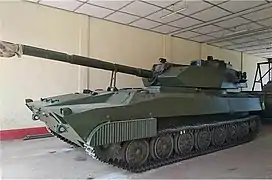 Locally made MMT-40 light tank with 105mm gun
Locally made MMT-40 light tank with 105mm gun Licence-built Thunder armoured personnel carrier of Myanmar Army
Licence-built Thunder armoured personnel carrier of Myanmar Army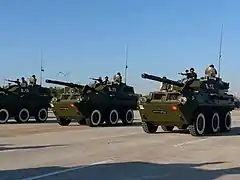 PTL-02(WMA-301) tank destroyers of Myanmar Army
PTL-02(WMA-301) tank destroyers of Myanmar Army Panhard AML 90 of Myanmar Army
Panhard AML 90 of Myanmar Army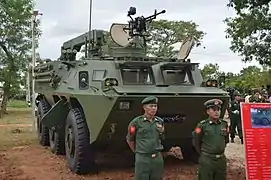 Type-92ARV(ZSL-92) armoured recovery vehicle of Myanmar Army
Type-92ARV(ZSL-92) armoured recovery vehicle of Myanmar Army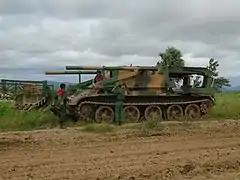 GSL-130 mine clearance vehicle of Myanmar Army
GSL-130 mine clearance vehicle of Myanmar Army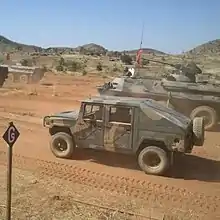 Naung Yoe (Humvee version) light armoured vehicle of Myanmar Army
Naung Yoe (Humvee version) light armoured vehicle of Myanmar Army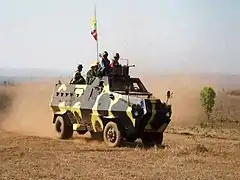 BAAC-87 armoured personnel carrier of Myanmar Army
BAAC-87 armoured personnel carrier of Myanmar Army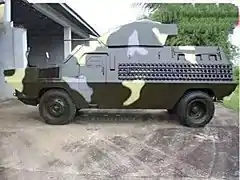 MAV-2 armoured personnel carrier of Myanmar Army
MAV-2 armoured personnel carrier of Myanmar Army 25mm Self-propelled anti-aircraft guns of Myanmar Army
25mm Self-propelled anti-aircraft guns of Myanmar Army.jpg.webp) SH-1 self-propelled artillery systems of Myanmar Army
SH-1 self-propelled artillery systems of Myanmar Army.jpg.webp) SH-1 self-propelled artillery systems of Myanmar Army
SH-1 self-propelled artillery systems of Myanmar Army Nora B52 self-propelled artillery system of Myanmar Army
Nora B52 self-propelled artillery system of Myanmar Army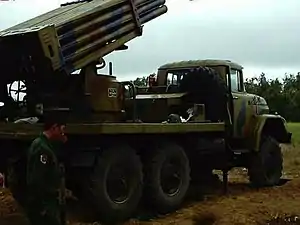 Upgraded 9P138 "Grad-1" rocket artillery system of Myanmar Army
Upgraded 9P138 "Grad-1" rocket artillery system of Myanmar Army Type-81 rocket artillery system of Myanmar Army
Type-81 rocket artillery system of Myanmar Army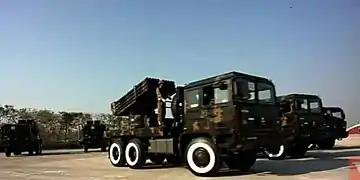 MAM-01B rocket artillery systems of Myanmar Army
MAM-01B rocket artillery systems of Myanmar Army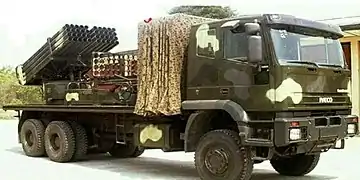 MAM01(Early Version) rocket artillery system of Myanmar Army
MAM01(Early Version) rocket artillery system of Myanmar Army MAM-01(Upgraded Version) rocket artillery system of Myanmar Army
MAM-01(Upgraded Version) rocket artillery system of Myanmar Army Production of MAM-01 rocket artillery systems by Myanmar Army
Production of MAM-01 rocket artillery systems by Myanmar Army MAM-01 MLRS which is being prepared to fire.
MAM-01 MLRS which is being prepared to fire.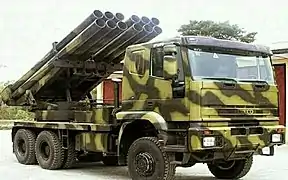 M-1991 rocket artillery system of Myanmar Army
M-1991 rocket artillery system of Myanmar Army MAM-02 240mm multiple launch rocket systems of Myanmar Army at the Armed Force Day Parade,2015
MAM-02 240mm multiple launch rocket systems of Myanmar Army at the Armed Force Day Parade,2015 GYD-1B(KS-1M) missile production facility of Myanmar Army
GYD-1B(KS-1M) missile production facility of Myanmar Army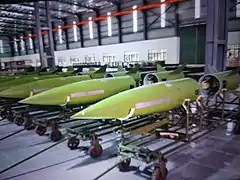 GYD-1B(KS-1M) missile production facility of Myanmar Army
GYD-1B(KS-1M) missile production facility of Myanmar Army MADV self-propelled short range air defence system of Myanmar Army
MADV self-propelled short range air defence system of Myanmar Army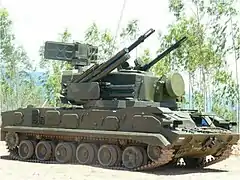 2K22M Tunguska air defence system of Myanmar Army
2K22M Tunguska air defence system of Myanmar Army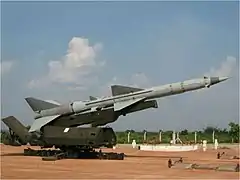 S-75M3 Volga-2 air defence system of Myanmar Army
S-75M3 Volga-2 air defence system of Myanmar Army Kub 2K12M2 air defence system of Myanmar Army
Kub 2K12M2 air defence system of Myanmar Army 1S91 "Straight Flush" radar of Myanmar Army
1S91 "Straight Flush" radar of Myanmar Army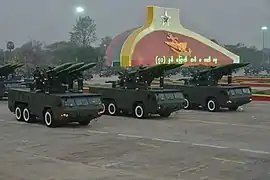 Kavadat-M air defence systems of Myanmar Army
Kavadat-M air defence systems of Myanmar Army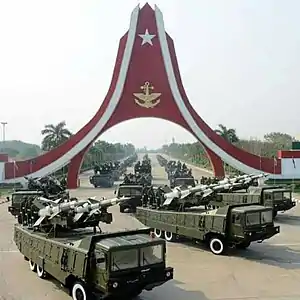 Pechora-2M air defence systems of Myanmar Army
Pechora-2M air defence systems of Myanmar Army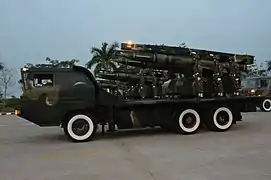 KS-1B air defence system of Myanmar Army
KS-1B air defence system of Myanmar Army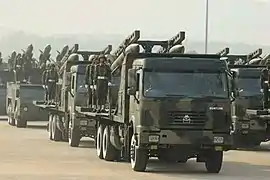 KS-1M SAM of Myanmar Army
KS-1M SAM of Myanmar Army
See also
- Ne Win
- Tatmadaw
- Myanmar Navy
- Myanmar Air Force
- Military Intelligence of Myanmar
- Myanmar Police Force
Note
- This representative emblem is also the Shoulder Sleeve Insignia (SSI) of the office of Commander-in-Chief of Myanmar Army.
References
- "Official site of Commander-in-Chief's Office of the Myanmar Armed Forces". Archived from the original on 14 June 2022. Retrieved 17 June 2022.
- International Institute for Strategic Studies (15 February 2023). The Military Balance 2023. London: Routledge. p. 275. ISBN 9781032508955.
- "Border Guard Force Scheme". Myanmar Peace Monitor. 11 January 2013. Archived from the original on 21 August 2020. Retrieved 8 August 2020.
- Maung Zaw (18 March 2015). "Taint of 1988 still lingers for rebooted student militia". Myanmar Times. Archived from the original on 19 February 2021. Retrieved 8 August 2020.
- The Asian Conventional Military Balance 2006 (PDF), Center for Strategic and International Studies, 26 June 2006, p. 4, archived (PDF) from the original on 29 April 2011, retrieved 20 March 2011
- "Myanmar allocates 1/4 of new budget to military". Associated Press. 1 March 2011. Archived from the original on 28 June 2011. Retrieved 9 March 2011.
- Working Papers – Strategic and Defence Studies Centre, Australian National University
- Selth, Andrew (2002): Burma's Armed Forces: Power Without Glory, Eastbridge. ISBN 1-891936-13-1
- Far Eastern Economic Review, 20 May 1981
- FEER, 7 July 1983
- Bertil Lintner, Land of Jade
- Asiaweek 21 February 1992
- The Defence of Thailand (Thai Government issue), p.15, April 1995
- "Myanmar's losing military strategy". Asia Times. 7 October 2006. Archived from the original on 13 May 2011. Retrieved 28 July 2010.
{{cite web}}: CS1 maint: unfit URL (link) - WP 342. Australian National University
- "Myanmar-Army Regional Military Commands". Global Security. GlobalSecurity.org. Archived from the original on 24 August 2021. Retrieved 23 September 2021.
- Myoe, Maung Aung: Building the tatmadaw – Myanmar Armed Forces Since 1948, Institute of SouthEast Asian Studies. ISBN 978-981-230-848-1
- "Junta Expands Military". Archived from the original on 2 March 2011. Retrieved 6 March 2011.
- "How Myanmar's shock troops led the assault that expelled the Rohingya". Reuters. 26 June 2018. Archived from the original on 17 July 2018. Retrieved 28 August 2018.
- "343 Light Infantry Battalion - WhoWasInCommand". whowasincommand.com. Archived from the original on 30 July 2023. Retrieved 23 May 2023.
- "The Kiev Connection". Archived from the original on 5 June 2011. Retrieved 13 September 2011.
- "Defense19". Archived from the original on 24 September 2015. Retrieved 29 November 2014.
- "Why Russia". Archived from the original on 5 December 2014. Retrieved 12 March 2015.
{{cite web}}: CS1 maint: unfit URL (link) - IndraStra Global Editorial Team (30 October 2020). "Myanmar Integrated Air Defense System". Archived from the original on 31 October 2020. Retrieved 7 December 2015.
- "Burmanet " Jane's Intelligence Review: Radio active – Desmond Ball and Samuel Blythe". Archived from the original on 6 December 2014. Retrieved 29 November 2014.
Further reading
- Samuel Blythe, 'Army conditions leave Myanmar under strength,' Jane's Defence Weekly, Vol. 43, Issue 14, 5 April 2006, 12.
- Beech, Hannah (4 April 2021). "Inside Myanmar's Army: 'They See Protesters as Criminals'". New York Times. Retrieved 11 April 2021.
External links
- Role of officers in Burmese Army (Part 1) Archived 25 February 2012 at the Wayback Machine Bo Htet Min, Mizzima, 23 January 2010
.svg.png.webp)